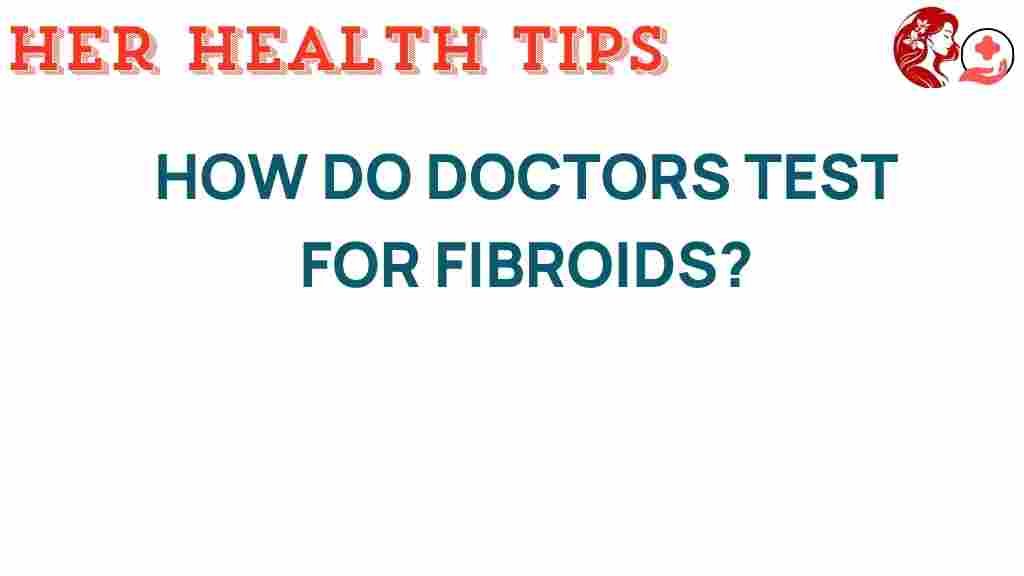Unveiling the Secrets: How Do Doctors Test for Fibroids?
Fibroids, also known as uterine leiomyomas, are non-cancerous growths that develop in the uterus. They are a common concern in women’s health, affecting many women during their reproductive years. Understanding how doctors test for fibroids is crucial for early diagnosis and effective treatment options. This article will explore the various medical testing methods used to diagnose fibroids, including ultrasound, MRI, and pelvic exams, and will discuss the implications of these findings on women’s health.
Understanding Fibroids
Before diving into testing methods, it’s essential to understand what fibroids are and how they can affect women’s health. Fibroids can vary in size, number, and location within the uterus. Some common symptoms include:
- Heavy menstrual bleeding
- Pelvic pain or pressure
- Frequent urination
- Difficulty emptying the bladder
- Constipation
- Back pain
Not all women with fibroids experience symptoms, and many may not even realize they have them until they undergo routine health diagnostics.
Step-by-Step Process: How Doctors Test for Fibroids
When a woman presents symptoms that may indicate the presence of fibroids, healthcare providers typically follow a structured approach to diagnosis. Here are the commonly used methods:
1. Pelvic Exam
The first step in the diagnostic process often involves a pelvic exam. During this exam, a doctor will:
- Check the size and shape of the uterus
- Palpate the abdomen for any abnormalities
- Assess for any masses or tenderness
A pelvic exam can help the doctor identify any potential issues, but further testing is usually required to confirm the presence of fibroids.
2. Ultrasound
One of the most common and effective methods for diagnosing fibroids is ultrasound. This imaging technique uses sound waves to create a picture of the uterus and can help identify the size and location of fibroids. There are two types of ultrasounds used:
- Transabdominal ultrasound: Conducted by placing a transducer on the abdomen.
- Transvaginal ultrasound: Performed by inserting a transducer into the vagina for a closer view.
Ultrasound is a non-invasive, painless procedure that provides valuable information about the uterus and is often the first line of testing for suspected fibroids.
3. MRI (Magnetic Resonance Imaging)
If the ultrasound results are inconclusive or if there is a need for a more detailed view, doctors may recommend an MRI. This imaging technique offers several advantages:
- High-resolution images of the uterus
- Ability to differentiate between fibroids and other types of tumors
- Assessment of the location and number of fibroids
MRI is particularly useful for women with multiple fibroids or those who are considering surgical treatment options.
4. Hysterosonography
Also known as a saline infusion sonogram, hysterosonography involves injecting a saline solution into the uterus during an ultrasound. This method enhances the imaging of the uterine cavity and allows for better visualization of fibroids that may be inside the uterus.
5. Hysteroscopy
In some cases, doctors may perform a hysteroscopy, a procedure that allows direct visualization of the inside of the uterus. A thin, lighted tube is inserted through the vagina and cervix into the uterus. This method is particularly useful for:
- Identifying fibroids within the uterine cavity
- Removing fibroids during the same procedure if necessary
Troubleshooting Tips for Patients
Undergoing tests for fibroids can be a source of anxiety for many women. Here are some tips to help navigate the process:
- Communicate openly: Discuss any concerns with your healthcare provider before the tests.
- Prepare for the exam: Follow any pre-test instructions, such as fasting or avoiding certain medications.
- Ask about the process: Understanding what to expect can alleviate anxiety.
- Consider bringing a support person: Having someone with you can provide comfort during the appointment.
Treatment Options After Diagnosis
Once fibroids are diagnosed, several treatment options are available, and the choice depends on various factors such as the size and location of the fibroids, symptoms, and the woman’s reproductive plans:
- Watchful waiting: If fibroids are small and asymptomatic, doctors may recommend monitoring them.
- Medications: Hormonal treatments can help reduce symptoms but may not eliminate fibroids.
- Minimally invasive procedures: Techniques like uterine artery embolization can shrink fibroids.
- Surgical options: In cases where fibroids cause significant problems, surgery may be necessary. Options include myomectomy (removal of fibroids) or hysterectomy (removal of the uterus).
It’s essential to discuss all available options with your healthcare provider to determine the best plan tailored to your health needs.
Conclusion
In summary, testing for fibroids involves a comprehensive approach that includes pelvic exams, ultrasounds, MRIs, and sometimes more invasive procedures. Understanding these health diagnostics can empower women to seek timely evaluation and treatment. If you suspect you have fibroids or experience related symptoms, do not hesitate to consult your healthcare provider. Early diagnosis can lead to better management and improved quality of life.
For more information on women’s health and fibroids, visit WomensHealth.gov. If you’re looking for support and community resources, check out this link.
This article is in the category Reproductive and created by HerHealthTips Team
